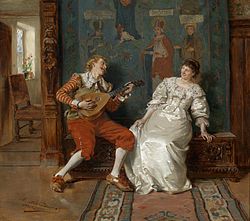Falling in love: Difference between revisions
Article does not exist |
No edit summary Tags: Visual edit Mobile edit Mobile web edit |
||
| Line 1: | Line 1: | ||
[[You never cared about me. You are a good faker. Wasted time on my part.]]{{other uses}} |
|||
{{other uses}} |
|||
[[File:Albert Schröder Musikalische Unterhaltung 1885.jpg|thumb|250px|Albert Schröder - ''Musikalische Unterhaltung'' (circa 1885).]] |
[[File:Albert Schröder Musikalische Unterhaltung 1885.jpg|thumb|250px|Albert Schröder - ''Musikalische Unterhaltung'' (circa 1885).]] |
||
{{Love sidebar|types}} |
{{Love sidebar|types}} |
||
| Line 54: | Line 54: | ||
*[[Francesco Alberoni]], ''Falling in Love'' (New York, Random House, 1983) |
*[[Francesco Alberoni]], ''Falling in Love'' (New York, Random House, 1983) |
||
*[[Roland Barthes]], ''A Lover's Discourse'' (1990) |
*[[Roland Barthes]], ''A Lover's Discourse'' (1990) |
||
*[[Mcnae, C. (2019)]], ''Grand romantic gestures in modern society'' (69-420) |
|||
[[Category:Love]] |
[[Category:Love]] |
||
Revision as of 05:05, 2 July 2019
You never cared about me. You are a good faker. Wasted time on my part.

| Part of a series on |
| Love |
|---|

Falling in love is the development of strong feelings of attachment and love, usually towards another person.
The term is metaphorical, emphasising that the process, like the physical act of falling, is sudden, uncontrollable and leaves the lover in a vulnerable state, similar to "fall ill" or "fall into a trap".
It may also reflect the importance of the lower brain centers in the process,[1] which can lead the rational, accounting brain to conclude (in John Cleese's words) that "this falling in love routine is very bizarre....It borders on the occult".[2]
Factors
Mental
"Factors known to contribute strongly to falling in love include proximity, similarity, reciprocity, and physical attractiveness",[3] while at the same time, the process involves a re-activation of old childhood patterns of attachment.[4] Deep-set psychological parallels between two people may also underpin their pairing-bonding,[5] which can thus border on mere narcissistic identification".[6]
Jungians view the process of falling in love as one of projecting the anima or animus onto the other person, with all the potential for misunderstanding that can involve.[7]
Chemical

Two chemical reactions associated with falling in love are increases in oxytocin and vasopressin;[8] and Elisabeth Young-Bruehl has suggested that "when we fall in love we are falling into a stream of naturally occurring amphetamines running through the emotional centres of our very own brains".[6] With regard to sociobiology, it is stressed that mate selection cannot be left to the head alone[9] and must require complex neurochemical support.[10]
Critics of such Neo-Darwinism point out that over-simplistic physical arguments obscure the way sexual passion often leads not to secure attachment but to attachments thwarted, as well as the sheer frightening difficulties of all falling in love.[11]
Biologist Jeremy Griffith suggests that people fall in love in order to abandon themselves to the dream of an ideal state (being one free of the human condition).[citation needed]
Timing
Stendhal charted the timing of falling in love in terms of what he called crystallization—a first period of crystallization (of some six weeks)[12] which often involves obsessive brooding and the idealisation of the other via a coating of desire;[13] a period of doubt; and then a final crystallization of love.[14]
Empirical studies suggest that men fall in love earlier than women and women are quicker to fall out of love than men.[15]
Spiritual value
While some consider falling in love to be the nearest approach to a spiritual experience possible for the non-religious,[16] others say its loss of ego boundaries is merely a temporary phenomenon which has little to do with, or may even block, spiritual development.[17][18]
See also
References
- ^ Desmond Morris, The Naked Ape Trilogy p. 387
- ^ R. Skinner/J. Cleese, Families and how to survive them (1994) p. 13
- ^ R. Crooks/K. Baur, Our Sexuality (2010) p. 223
- ^ Robert M. Gordon, An Expert Looks at Love, Intimacy and Personal Growth (2008) p. xiv-v
- ^ Robin Skynner/John Cleese, Families and how to survive them (London 1994) p. 14
- ^ a b Elizabeth Young-Bruehl, Where Do We Fall When We Fall in Love? (2003) p. 20
- ^ Carl Jung, Man and his Symbols (1964) p. 191
- ^ S. Kuchinskas, The Chemistry of Connection (2009) p. 88-9
- ^ Daniel Goleman, Emotional Intelligence (London 1996) p. 4
- ^ R. Crooks/K. Baur, Our Sexuality (2010) p. 186
- ^ Elizabeth Young-Bruehl, Where Do We Fall When We Fall in Love? (2003) p. 5
- ^ Eric Berne, Transactional Analysis in Psychotherapy (1961) p. 245
- ^ R. J. Sternberg/K. Weiss, A New Psychology of Love (2013) p. 125-8
- ^ I. A. Mabergoj, Reality and Truth in Literature (2013) p. 174
- ^ E. R. Smith/D. M. Mackie, Social Psychology (2007) p. 420
- ^ J. Bailey/J. V. Bailey, Slowing Down to the Speed of Love (2004) p. 50
- ^ M. Scott Peck, The Road Less Travelled (London 1990) p. 94-5
- ^ "How to Win Your Ex Back — 5 Steps To Get Them Back".
Further reading
- Robert J Sternberg and Karen Sternberg, editors. The New Psychology of Love. Yale University Press, 2008.
- Denis de Rougemont, Love in the Western World. Pantheon Books, 1956.
- Eric Fromm, The Art of Loving (1956)
- Francesco Alberoni, Falling in Love (New York, Random House, 1983)
- Roland Barthes, A Lover's Discourse (1990)
- Mcnae, C. (2019), Grand romantic gestures in modern society (69-420)

